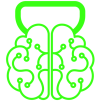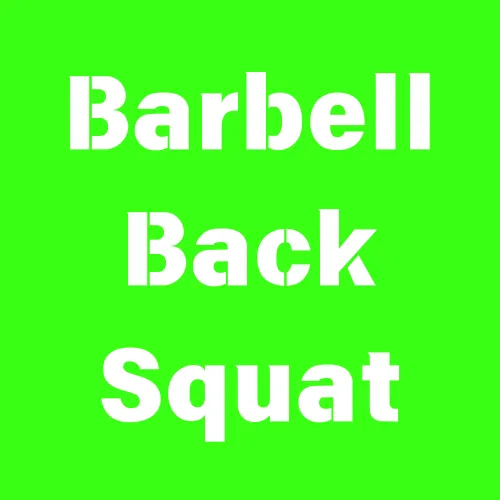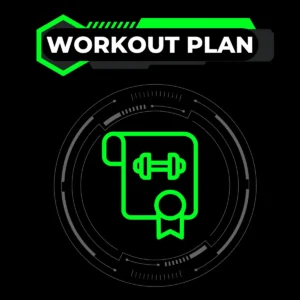The barbell back squat is a compound movement that primarily targets the lower body and core. As one of the “big three” powerlifting exercises, it’s a cornerstone in many training programs due to its versatility and effectiveness. Whether you’re looking to build muscle, increase strength, or improve functional fitness, the barbell back squat is a must-have in your routine.
But why is it so crucial? Unlike isolation exercises, the back squat works multiple muscle groups simultaneously, making it efficient and highly impactful. This article will explore every aspect of the barbell back squat to help you master it.
| Category | Details |
| Target Muscle Group | Quadriceps (Primary), Glutes, Hamstrings, Core |
| Exercise Type | Strength Training |
| Equipment Needed | Barbell and Weight Plates |
| Force Type | Push |
| Training Level | Beginner to Advanced |
| Supporting Muscles | Lower Back (Erector Spinae), Calves (Gastrocnemius), Core Stabilizers |
| Mechanics | Compound |
Primary Muscle Groups Worked in Barbell Back Squat
The barbell back squat primarily targets three major muscle groups:
Quadriceps
The quadriceps are the large muscles at the front of the thighs. During the squat, the quads are most active as you push upwards from the squat’s bottom position, extending the knees. These muscles are critical for running, jumping, and walking upstairs. Strong quads improve knee stability and protect against injuries.
Gluteus Maximus
The glutes are the largest muscles in the body and are heavily involved in the barbell back squat. They generate explosive power during the upward phase of the squat, particularly when you reach the “lockout” position at the top. Strong glutes not only contribute to aesthetic goals but also support hip stability and overall lower-body strength.
Hamstrings
Located at the back of the thighs, the hamstrings assist in controlling the descent during the squat and help in hip extension as you rise. Balanced hamstring strength is essential to prevent injuries, especially for athletes who sprint or perform high-impact movements.
Secondary Muscle Groups Engaged in Barbell Back Squat
In addition to the primary muscles, the barbell back squat also engages several secondary muscles, which play supporting roles:
Lower Back (Erector Spinae)
The lower back muscles help stabilize the spine throughout the movement. They work isometrically to prevent your torso from collapsing under the barbell’s weight. A strong lower back reduces the risk of injury in other lifts and daily activities.
Core Muscles
Your core acts as a natural belt, keeping your torso rigid during the squat. The rectus abdominis, obliques, and transverse abdominis are all activated to maintain balance and stability. A strong core enhances your performance in other exercises and improves posture.
Adductors (Inner Thighs)
The adductors assist in controlling leg movement, especially during deep squats. They help keep your knees in alignment and contribute to stability when balancing heavy weights.
Calves
The calves play a smaller role in the squat, but they are engaged to maintain stability, especially at the bottom position. They also assist in ankle mobility, which is crucial for proper squat depth.
Instructions For Barbell Back Squat
To perform the barbell back squat correctly, follow these step-by-step instructions:
- Setup:
- Adjust the squat rack so the barbell is at chest height.
- Load the barbell with an appropriate amount of weight. Use safety clips to secure the plates.
- Bar Placement:
- Position the barbell across your upper traps (high-bar position) or rear delts (low-bar position).
- Keep your grip tight, with hands slightly wider than shoulder-width.
- Unrack the Bar:
- Step under the bar, positioning it evenly on your back.
- Engage your core and stand up to lift the bar off the rack. Take two steps back.
- Stance:
- Stand with your feet shoulder-width apart, toes pointing slightly outward.
- Distribute your weight evenly between your heels and midfoot.
- Descent:
- Push your hips back and bend your knees simultaneously.
- Lower yourself until your thighs are at least parallel to the floor, keeping your chest up and back neutral.
- Ascent:
- Drive through your heels and push your knees outward to stand back up.
- Maintain control and avoid locking your knees at the top.
- Re-Rack:
- After completing your set, step forward and place the barbell back on the rack.
Benefits of Barbell Back Squat
The barbell back squat offers a plethora of benefits:
1. Strength Development
It’s one of the best exercises for building strength in the quads, hamstrings, and glutes. Over time, you’ll notice improved lifting performance across other exercises.
2. Improved Athleticism
Squats enhance explosive power, agility, and coordination—key attributes for athletes in almost any sport.
3. Boosts Hormonal Response
Heavy squats stimulate the release of growth hormone and testosterone, which are vital for muscle growth and recovery.
4. Enhances Functional Fitness
Squats mimic real-life movements like sitting, standing, and lifting, making them practical for daily activities.
5. Strengthens Bones and Joints
The load placed on your body during squats improves bone density and strengthens the connective tissues around your knees and hips.
Variations of Barbell Back Squat
To add variety to your workouts or target different muscle groups, consider these squat variations:
Front Squat
The barbell is placed on the front of your shoulders, increasing core engagement and focusing more on the quads.
Low-Bar Back Squat
The barbell rests lower on your back, shifting the emphasis to the glutes and hamstrings.
Pause Squat
Hold the bottom position of the squat for 2-3 seconds to build strength and improve stability.
Goblet Squat
Ideal for beginners, this variation uses a dumbbell or kettlebell held close to the chest for easier balance and form.
Common Mistakes in Barbell Back Squat
Avoid these common errors to ensure proper form and safety:
- Rounding the Back
- Keep your chest up and spine neutral throughout the lift.
- Knees Caving Inward
- Push your knees outward to maintain proper alignment.
- Shallow Depth
- Aim for at least parallel depth to maximize muscle activation.
- Overloading the Bar
- Start with lighter weights and increase gradually to avoid compromising form.
Safety and Precautions For Barbell Back Squat
- Warm up thoroughly before squatting to prevent injuries.
- Use a squat rack with safety pins when lifting heavy.
- Wear proper footwear with a flat sole for better stability.
- If unsure about form, consult a trainer or start with bodyweight squats.
Equipment Needed In Barbell Back Squat
To perform the barbell back squat, you’ll need:
- Barbell
- Weight plates
- Squat rack or power cage
- Optional: lifting belt, knee sleeves, and weightlifting shoes
Alternative Exercises For Barbell Back Squat
If you’re unable to perform the barbell back squat, try these alternatives:
- Leg Press: A machine-based exercise that isolates the quads and glutes.
- Split Squat: Targets one leg at a time for improved balance and symmetry.
- Deadlift: Focuses on the posterior chain while complementing the squat.
Other Names of Barbell Back Squat
The barbell back squat is also referred to as:
- High-Bar Squat
- Low-Bar Squat (depending on bar placement)
Enhance Your Squat Training: Must-Read Resources
The Barbell Back Squat is a fundamental compound exercise for building lower body strength, targeting the quadriceps, hamstrings, glutes, and core. To gain a deeper understanding of lower body muscle anatomy and squat mechanics, check out this comprehensive guide on ExRx.net.
For those looking to refine their squat technique and explore variations (such as front squats or pause squats), expert advice and training tips are available on Bodybuilding.com. Whether you’re a beginner or an advanced athlete, this resource is designed to take your lower body training to the next level.
Proper form and safety are essential to maximize results and prevent injury during this exercise. Learn more about squat safety, setup, and execution techniques from the trusted Mayo Clinic.
Conclusion
The barbell back squat is more than just an exercise—it’s a powerful tool to build strength, improve athleticism, and enhance overall health. By mastering proper form, avoiding common mistakes, and incorporating variations, you’ll unlock its full potential and enjoy long-lasting results.
If you’re looking for more exercises to build strength and improve performance, be sure to check out our Leg Library. You’ll find comprehensive guides, workout plans, and expert tips to enhance your lower body training.
For a complete collection of exercises targeting all muscle groups, visit our Exercise Library. Discover detailed guides and specialized workouts to elevate your fitness journey and achieve your goals!



